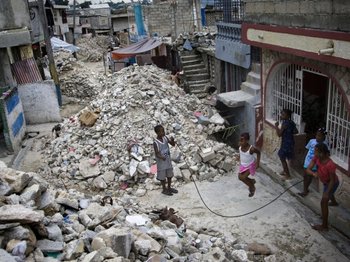There’s a common folk tale that paints the picture of six blind men who come across an elephant for the first time. Each of the men approaches the elephant and blindly feels what is in front of him. One finds the trunk, another the tail, another the foot, another the ear and so on.
Afterwards, the men discuss the elephant: “An elephant is like a strong pillar” says the man who felt the leg. “What are you talking about?” asks the man who felt the tail, “the elephant is clearly like the brush we use to sweep the floors. It’s thin and hairy – not at all like a pillar”. The others chime in with their own experience, all certain the others must be mad, for they each felt the elephant with their own hands – they know what an elephant is, surely!
You may be thinking – what does this have to do with humanitarian response? Like the six blind men in the tale, humanitarians responding in urban contexts have approached the city in the same way the men approached the elephant. Shelter is addressed without considering health, as the blind men felt the leg but not the tail. We address the household without local governance and politics, like the men experienced the trunk but not the ears. Experienced on their own, the seperate parts do not paint a full picture.

Photo credit: UN Photo/Marco Dormino
Launched this week, ALNAP’s latest research on urban crises ‘Stepping Back: Understanding Cities and their Systems’ explores the nature of urban contexts, and the potential of systems thinking as a way to improve our understanding of urban spaces. It argues the importance of stepping back as a first step towards changing policy and practice.
Critically, as a sector we do not build in time to step back and understand the city – and in doing so, we risk a lot. 54% of the world’s population now lives in urban spaces, with low-income countries seeing the fastest rate of urbanisation. A lack of capacity and high levels of vulnerability in these urban contexts often mean humanitarian aid will be needed when crisis hits.
Next week, 45,000 people will gather in Quito, Ecuador, for Habitat 3 to discuss, learn, and commit to improving urban settlements worldwide. With the world’s eye on urban spaces this week, how can we change how humanitarians approach the city going forward? As part of the New Urban Agenda, humanitarians can start by recognising that:
- Understanding cities requires more than looking at one element of the system, or one level of analysis. Just as elephants are more than their tails or their trunks, cities are more than any one sector, neighbourhood or actor. Cities are systems – often complex ones, full of interconnections and constantly changing.
- Understanding the city is not easy; there are institutional and individual barriers to overcome. We can choose to understand all of an urban context, take its uncertainty and complexity as fact, and think and act differently.
- Understanding interconnectedness in systems such as cities takes more than laying out all of the pieces. While the blind men may eventually realise they are all right and be able to describe all of the parts of the elephant, they will not understand how they fit together. Humanitarians must accept that cities are too complex to understand comprehensively – but step up our efforts to understand as much as we can. This means doing more observation and adaptation and perhaps less planning and implementation.
ALNAP is in Quito this week following the humanitarian aspects of Habitat3.